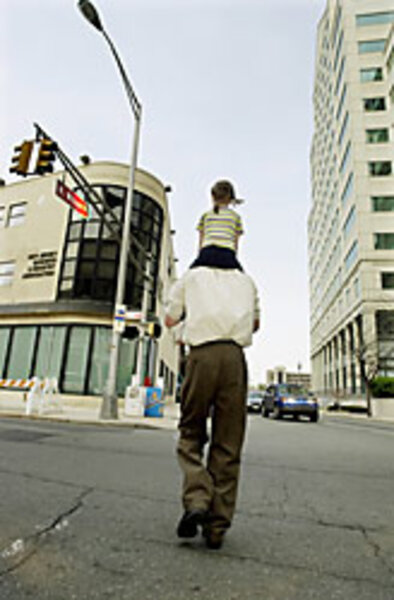When work and life go together
Loading...
I sat in a Vietnamese diner in Seattle and ate supper. A 10-year-old boy came up to clear away my plate, while his older sister sat in another booth and did her homework. A few other kids were helping their dad, the official waiter, while their mom did the cooking.
I sat back to read the newspaper and turned to an announcement for Take Our Daughters and Sons to Work Day. It made me think: The kids at the diner go to their parents' workplace every day, just as I did when I was their age.
Work and life weren't separate in my childhood because my dad ran his own upholstery shop.
I remember my mother saying, "Here, take this sandwich to your father," as she handed me a plate.
I took it and walked from the kitchen downstairs to our garage. We didn't keep cars there. Instead, it was the shop where my dad made tattered sofas and sagging chairs look new again.
Dad was at his sewing machine. The needle clattered up and down as a tall bobbin of thread spun round and round. A radio played big-band songs. Dad looked up, smiled, and said, "Thanks."
He kept working while I set the plate on the large table surrounding his sewing machine. Then I climbed up on the table, too. I sat cross-legged and looked around the shop.
Long fluorescent lights washed the place in cool, bright light. Dad kept the garage doors open in summertime for fresh air. But in winter, a space heater glowed orange-hot to keep the garage warm. Nighttime peeked through the plain aluminum-framed windows.
The floor was concrete, smooth enough to roller skate on when it rained and I couldn't go outdoors. Behind me were deep shelves that my dad had built from two-by-fours. They held long, round bolts of fabric that smelled of chemicals – I hid up there sometimes and pressed my nose against them.
In the corner stood spools of skinny piping and fluffy cotton batting. Pattern pieces and sewing tools hung from hooks on the walls.
I was only 5 at the time, but over the next few years I learned a great deal about upholstery by "helping" my dad and watching him work.
He started by carefully taking the cover off a ragged couch or chair. He used those faded pieces to make a pattern on heavy brown paper, marking numbers on each piece with a black grease pencil. Then he smoothed out the new fabric and cut it with his sharp, heavy scissors.
If the fabric had a design in it, such as plaid or flowers, the job was twice as hard – the design always had to match up at the edges when he sewed the pieces together. Then Dad (sometimes with Mom) lifted the stripped wooden chair skeleton onto sawhorses. He tightened the springs in the seat, tying them with twisted brown string, and he stuffed the frame with thick, coarse cotton.
Then he held the new fabric pieces against the frame with one hand and operated the electric stapler with the other. The air compressor hummed and the stapler went poom! poom! poom! It sounded like soft gunshot, and it was fast.
Some of the edges and corners were complicated, so he tacked them by hand. It was my job to hold spiky upholstery tacks for him in my cupped hands.
He showed me how he had to manage when I couldn't be there. He put a small handful of tacks into his mouth, then dipped the magnetic-tipped upholstery hammer in to get them. That way he could hold the fabric flat with one hand and hammer in tacks with the other.
We all worked for my dad. My older brother eventually had a grown-up job in the shop with a schedule to keep.
My other brother and I helped by doing small jobs when we were available. But all of us got paid, and for that, we had to do quality work. We thought it was fun – we never realized that our parents were teaching us to work. Work was part of life.
After this reverie, I looked up again at the kids working in their family's diner. To them, I was simply a customer. To me, they were young people who were slowly learning how to get things done in the real world of work. Sometimes that takes more than just a day.





